This paper mobilizes a Multi-Level Perspective (MLP) approach highlighting the political and social aspects of the transition process to discuss what factor explains Brazil’s apparent slowness in the energy transition process in the face of climate change challenges. The research concluded that Brazil already has a clean energy matrix compared to other countries, but it is poor in its share of wind
and solar energy; the country remains dependent on hydro as the main renewable; and engages in a substitution process of hydro with natural gas, which pollutes less but still emits greenhouse gases (GHG).

Sustainability transition is a long and complex process involving multiple elements, actors, uncertainties and constant disagreement (Kern & Markard 2016, Labussière & Nadai 2018). Regarding the energy transition, we refer to the sector responsible for 60% of GHG emissions in the world, the most critical political issue linking climate change and development in the 21st century (IEA 2022). This entails a destabilization of the actual energy paradigm and the development and diffusion of renewable energy innovations. As Halsnaes et al. (2011) discussed, development is always associated with decreasing energy intensity and increasing energy efficiency in long-term use.
Notwithstanding, in the short-term, a rise in fossil fuel usage might happen because of the energy sector adaptation, and maybe more emissions, until the maturation of renewable energy technologies (RE). Technological advances enable new renewable energy systems, which are essential to reorder this discussion due to the enormous reduction of waste, space, and emissions (Peters et al. 2011). Furthermore, technological changes impact institutional structures and existing organizations, including significant changes in business models, value chains, ownership structures, and consumer behavior, among others. These far-reaching change processes are called socio-technical transitions (Kern & Markard 2016).
The share of renewables has risen in the last years around the world (IEA 2022), which suggests a shorter road toward net-zero emission (Scholten et al. 2020). However, developed and developing countries face different challenges. While GHG emissions are externalities of anthropic actions mainly provoked by rich countries in the development process, energy transition requires national actions to fight global climate change. This reminds us of the Common But Differentiated Responsibilities Principle (CBDRP). Most of the developed countries have experienced an increase in the share of renewables in their energy mix because they have financed innovations for these technologies, and mitigation policies at high stakes. But developing countries, especially in South America, are far from the innovation frontier and have difficulty developing and diffusing modern renewable energy technologies despite their clean and mostly renewable energy mix. In this way, renewable energies seem to be an alternative “answer to all problems” but may be accessible only to developed countries.
Considering that Brazil already has some institutional structures to drive the energy transition, this paper poses the following question: what explains the Brazilian apparent slowness in the creation of a socio-technical assemblage of energy transition regarding the challenges related to the impacts of climate change?
Considering that Brazil already has some institutional structures to drive the energy transition, this paper poses the following question: what explains the Brazilian apparent slowness in the creation of a socio-technical assemblage of energy transition regarding the challenges related to the impacts of climate change? Delgado and Nogueira (2020) state that the energy transition agenda is nothing new in Brazil due to the availability of renewable resources, mainly hydro, and that the country has been using biofuels since 1931. However, strong dependence on hydropower and oil for energy generation may not be the best alternative. New renewable sources with greater energy matrix diversification are a more current response to the challenges in ensuring energy security and promoting transition.
We work with these assumptions:
We have adopted the Multilevel Perspective as a relational approach theory to recreate the socio-technical assemblage of energy transition (STA) (Labussière & Nadai 2018), with a qualitative approach, documental analysis and basic descriptive energy statistics from reliable databases.
Given the purposes of the article, it is organized into four sections, in addition to this introduction. The first section brings some theoretical elements that support the analysis of energy transition; the second section presents an overview of the energy transition in South America; the third presents the case of Brazil, considering its current status of energy transition and its challenges; we finish with our conclusions.
SUSTAINABILITY TRANSITION AND ENERGY TRANSITION
Energy Transition is an analytical category from a large field named Sustainability Transition Studies (STS) (Markard 2012). Derived from many other disciplines such as Engineering, Social Sciences, Business, Economics, Innovation Studies and Political Science, STS are considered a prominent field that requires multidisciplinary contributions. The field International Relations has not paid much attention to this analytical category (or even to energy as a macro category), which means that there are few contributions from internationalists' perspectives crossing power dynamics, international cooperation, or foreign policy.
In practice, energy transitions are described as a process to destabilize the actual energy paradigm toward a green economy with the implementation of modern renewable energy technologies (Criekemans 2018, Scholten et al. 2020, O’Sullivan et al. 2017). Transitions are driven by different origins. One can state that the main origin is related to the trade-off between climate change and energy security. On the one hand, energy security requires limitless accessibility to energy to reach a country's demand, and fossil fuel technologies are well established, matured, reliable, and can be a supply. On the other hand, climate change mitigation policies require an increase in the share of renewable energies in the energy mix, reaching a net-zero emission situation shortly. In any case, dealing with the trade-off must be done openly in front of society so the transitions can be achieved.
In recent years, energy actors have presented policies, practices and technologies that perhaps will overcome the trade-off. National actions are quite important because they tackle the problem as it appears. But, without international cooperation, countries may face difficulties in fighting climate change (Criekemans 2018, Scholten et al. 2020).
Transitions are considered a multi-actor arena where some actors win and others lose. In a governance approach of transition, governments, firms, high-education institutions, society, and media play different roles. Sometimes they are synergetic when one's failure is compensated by another’s success. Sometimes they are antagonistic when actors seek different results from the transition, limiting or delaying the process. Sometimes they are neutral. These different dynamics of action cast light on the presence of an innovation perspective. Actors involved in the destabilization must innovate and produce different technologies as products or processes that reflect the actual political missions (Avelino 2017, Mazzucato 2015).
This process must happen on both the national and international levels. Inefficient and emission-intense technologies must leave the energy market, and renewable technologies must disrupt the sector and destabilize the traditional market. In other words, it is a creative destruction process. At the international level, countries pursue the knowledge and development of these renewable technologies. They seek better trade agreements, a better position in knowledge accumulation, and, of course, a good “green” reputation. Countries that are investing in renewable energies will have a distinguished position in future international relations (Avelino & Wittmayer 2016).
Sustainability is not endogenously renewable. The qualitative (shared political and social impacts and benefits) or quantitative (installed capacity, productivity efficiency, energy balance, costs and prices) aspects of a transition are the factors that make this transition renewable and sustainable – destabilizing the core of the problem – or just sustainable – presenting adjustments but preserving the core of the problem. They are based on political effort and technological infrastructure. This means that energy plans and policies should offer goals and methodologies for technological project development (Labussière & Nadai 2018).
The socio-technical assemblage (STA) is an interesting approach that seems to grasp this long, intertwined and relational process. There are many elements to be identified, and their relation to the transitional energy potential analyzed. Our inquiry into energy transition with the STA starts by identifying the socio-technical object, the technology under scrutiny. It can be one (solar or on/offshore wind power, for example), or those taken by association (renewable energies, smart grids, or transitions, for example).
It is important to be aware of oriented connections, which are some aspects that, intentionally or not, bond entities in transition and the technology itself (Labussière and Nadai 2018). We aim to identify two central relations: specification and amplification. Specifications are confrontations around singular materialities and the requalification of entities that endow them with new capacities for action. Amplifications are processes in which a critical viewpoint is derived about how energy transition processes trigger or address interferences: “Each is seen as complementary: specification paves the way for redefinitions and co-articulations, which both allow for enlarged compatibilities between individual experiences and collective ventures (amplification)” (Labussière & Nadai 2018, 31).
Technology is responsible for guiding the presence or absence of political entities and actors, the resources mobilized, the space where the transition happens, and the timeframe in terms of plans and projects. In turn, it is appropriate to identify the social relevance of this technology; namely, following the social development of technology over time, such as the political, material, and social challenges, roadmaps, and plans, institutional building, social movements, mass media communication, and market structures (Labussière & Nadai 2018, 24).
The analysis of the assemblage can be done by varying between observing the hermetic development of a single technology in a niche, or correlating the development with the international context concerning three levels:
STA can be observed from a multilevel perspective because of the transnational development of technologies in the 21st century. In this cycle, the STA determines what we must search to understand the development of the technology. Depending on the level of analysis, the multi-actor arena provokes different interactions in the energy transition. Figure 1 shows a synthesis of this relational process.
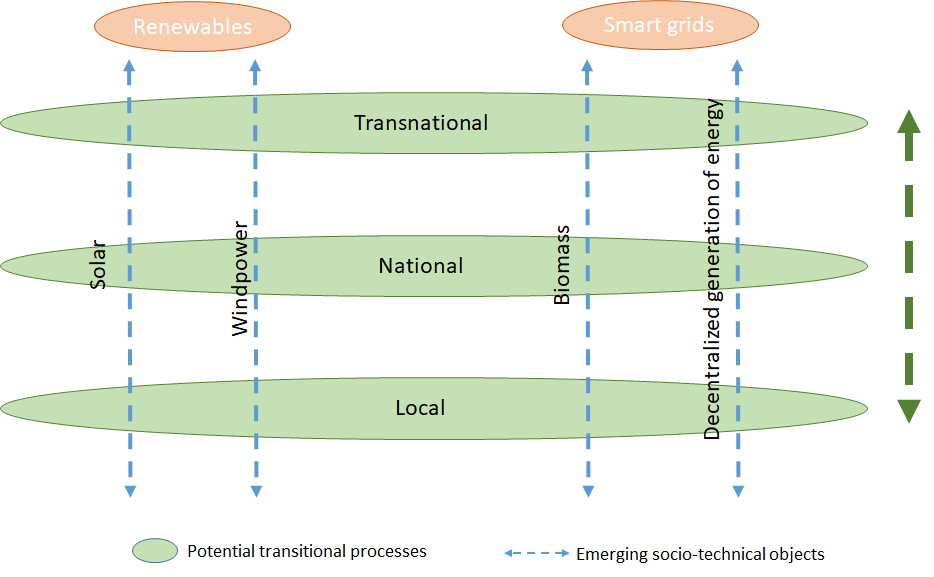
Figure 1 – Relation of potential transitional process and socio-technical object. Source: Based on Labussière & Nadai (2018).
We acknowledge the international trend to speed up transitions and the urgency to reduce GHG emissions, which results in accessibility for people at affordable prices and commitment to international concerns regarding climate effects. Nevertheless, depending on the international region, the transnational transition might face peculiarities or is simply difficult to achieve. So, in the next section, we cover the energy potential transitional process profile in South America.
THE SOUTH AMERICAN ENERGY SECTOR PROFILE
Even though South American countries have a distinct and loose obligation to reduce emissions (due to CBDRP), energy transition implies the development and diffusion of innovations within the countries, collaboration, and, perhaps, deeper transnational integration of the energy market. The transnational level of the socio-technical assemblage of renewable energy technologies for South America can be analyzed in terms of the international technological tendencies and political agreements to fight climate change and improve energy security (Labussière & Nadai 2018).
The transnational aspect of an energy transition can be exemplified by the European Union case. When transition is made collaboratively, in terms of knowledge and scientific pool, and cooperatively, in terms of international agreements and goals, it has the potential to benefit different countries in different stages of transition to speed up their process. The benefits of a socio-technical object, such as renewable energies, are observed in the increase of renewables and the decrease of fossil fuels in the European Union energy mix (Souza & Ferreira 2020). Beyond that, is the advance of countries towards the development of a socio-technical assemblage of policies, nationally or internationally, that privilege the advance of technology. Horizon 2020, the last E.U. innovation support program, was responsible for promoting collaborative knowledge production on renewables, varying from products, patents, academic papers and policy papers (Horizon Dashboard 2022). Moreover, the E.U. has many strategies at the transnational level to engage members in a more renewable mix, cutting emissions and investing in renewable innovations.
The European Union structure is a unique case because the integration project has developed since its design (Ferreira 2021). However, many South American countries have come through different integration projects that indicate concern over the energy sector. Mercosur did not discuss it in its beginning, but the integration was designed as a common market and would offer baselines for transmission lines among members, which is not enough. Unasur was another integration effort. Although it has not moved forward, the agreement has provisions to stimulate cooperation among its members in the energy sector. Both Mercosur and Unasur could be transnational arenas to design common energy strategies to deal with energy security and transition similar to the European Union.
Energy security is a definition constantly followed by the intention of what is conceived as the role of energy in society. To avoid an extended discussion around the topic, we define energy security as the “uninterrupted availability of energy resources at affordable prices” (IEA 2015). The definition might be comprehensive and vague, but it is intentionally dealt with in this way to relate it to climate change.
Countries are seeking security and efficiency in this sector, and they need to be committed to the international agreements signed. Sustainable Development Goals (SDG), its Targets, and Indicators are a reliable way to evaluate the energy profile in South America. SDGs 7 and 9 can be used as references to understand the status. SDG 7 is to “Ensure access to affordable, reliable, sustainable and modern energy for all”, and Goal 9 is to “Build resilient infrastructure, promote inclusive and sustainable industrialization and foster innovation” (U.N. 2022). We selected indicators 7.1, 7.2, 7.3 and 9.4 to collect data comparing the beginning of SDG, in 2015, and the closest and most reliable data. Table 1 shows them.
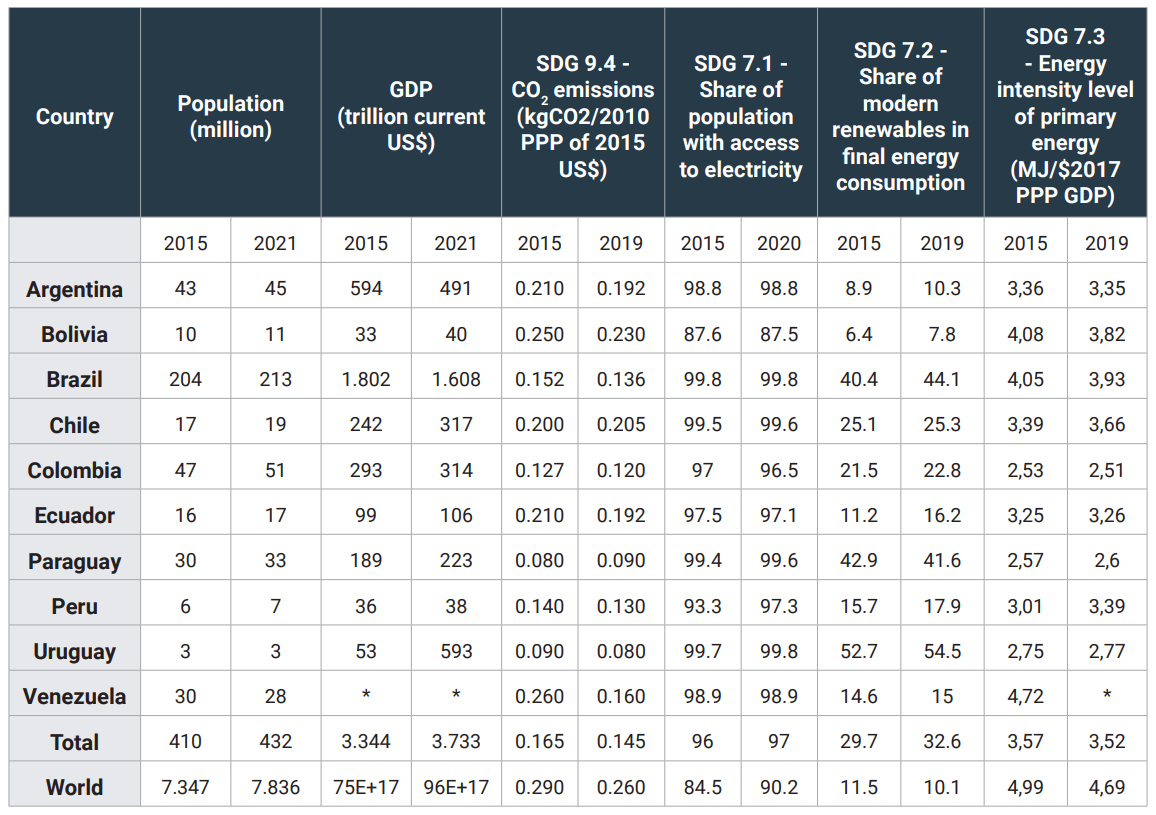
Table 1 – SDG indicators. Source: World Bank (2022), IEA (2022), OLADE (2022).
** Data not found in our sources.
Our data suggest that, despite the increase in population, CO2 emissions have dropped. This is followed by an increase in SDG 7.1 and 7.2, which suggests that the countries have pursued better and more efficient energy policies, in terms of guaranteeing access to the population and its diffusion. More importantly, there has been a higher possibility to consume from a renewable source. Based on SDG 7 and 9, South American countries are closer to reaching their net-zero emission target by 2030 than others. Unfortunately, at this point, there is no transnational plan for the region to trigger a specification process in which collective knowledge is developed and shared to achieve the Agenda 2030 targets in coordination (Labussière & Nadai 2018). This leaves countries with different economic performances to design and pursue energy transition individually, which is less efficient.
According to Geoffrey Wood (2022), South American countries face challenges in carrying out their energy transition while also having some advantages. The challenges are the critical dependence on fossil fuel to supply mobility, the economic relevance of extractivism, and the fact that the countries are major exporters of commodities, a “somewhat paradoxical position given that the same drivers of climate change (hydrocarbons and extractives) have also largely driven development in the region” (Wood 2022, 5). The region is still one of the most vulnerable to climate change's impacts, while water is one of the primary sources of energy generation. The worsening of natural events has caused more frequent natural disasters, affecting energy generation and agriculture.
The advantages are the abundant natural resources to produce renewable energies from hydro and biofuels, and the high annual presence of sun and wind. Progress has been made toward diversifying sources, including wind, solar and geothermal. Investments in renewables have grown 11 times since 2014, which is twice the world average (Wood 2022). In addition, Chile and Mexico are joining Brazil as the tenth-largest renewable energy markets. Figure 2 presents the total energy balance.
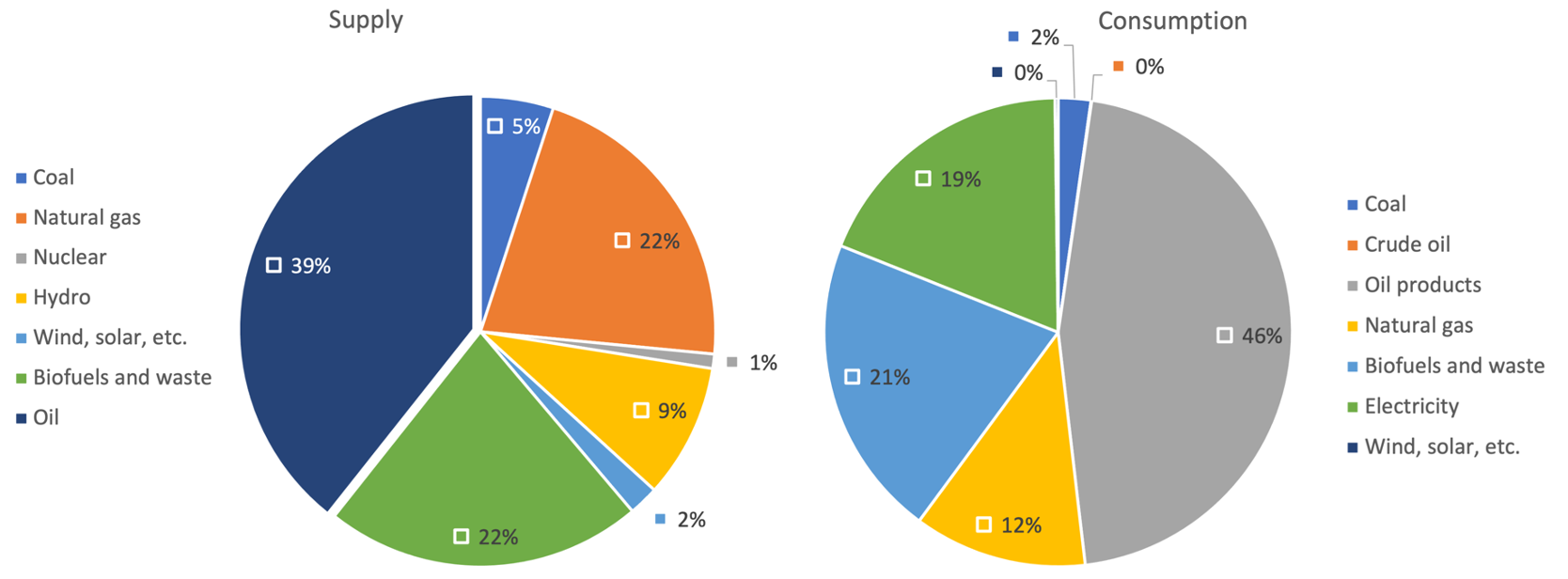
Figure 2 – South American total energy by source. Source: IEA (2022).
Responses to climate change require transnational cooperation because adverse effects from neighbors matter. Access to energy is fundamental to reducing poverty, which foments economic growth and sustainable development policies to increase the demand for energy innovations. Transition can upgrade energy generation with modern technologies, digitalizing the sector and distributing high-quality energy from renewable and efficient sources (Graf 2015).
According to OLADE (2022), a drop in total energy sector emissions in the region from 269 MtCO2 in 2019 to 222 MtCO2 in 2050 is anticipated. South American countries are in a comfortable position for a specification process. The countries have space to invest more in transnational collaborative science to destabilize the current energy market and penetrate it with modern renewables and firms. Since specification and amplification are complementary, the next step would be the amplification with more institutions and regulations that can provide a coordinated strategy for transition (Labussière & Nadai 2018).
Considering the advantages, challenges and opportunities for South American countries, the region has room for a rapid transition. But while observing each country individually, one very interesting case that catches our attention is the position of Brazil in this transnational socio-technical assemblage.
Considering the advantages, challenges and opportunities for South American countries, the region has room for a rapid transition. But while observing each country individually, one very interesting case that catches our attention is the position of Brazil in this transnational socio-technical assemblage. According to Table 1, the country has already achieved every SDG target presented, but the energy sector relies heavily on hydropower and has less consideration for wind and solar technologies.
Despite the drop in energy intensity, energy efficiency is still under pressure. From 2014 to 2018, the country experienced a negative saving of 90 PJ for industry and 5 PJ for transportation (IEA 2022). Brazil has a comfortable position to design and manage a national socio-technical assemblage toward an energy transition. Besides the challenges in the electrification of transport, institutional and legal arrangements, and renewable innovation policies, Brazil may perform as well as Germany did in the E.U. case, where it has led the transnational process with its neighbors (Souza & Ferreira 2020). In the next section, we analyze the challenges in the Brazilian socio-technical assemblage of energy transition.
POLITICAL AND STRUCTURAL CHALLENGES IN THE BRAZILIAN ENERGY TRANSITION
Considering the assumptions presented in our introduction, it is relevant to observe the Brazilian case because:
1) Energy transitions are broader processes that not only update and expand energy markets, but that directly produce profound changes in the technologies of production, and, indirectly, in the production chains;
2) There are individual efforts from some South American countries, which even encourage a certain degree of energy integration, but we could not identify sufficient governance mechanisms for this process that could benefit the subcontinent;
3) Considering the size and relevance of the energy sector in Brazil, the country, by delaying its process, may also decrease a more significant deepening of energy integration in the subcontinent.
South American countries have great potential to be at the forefront of this global energy transition due to the elements discussed above. Somehow, the countries are seeking this goal as well as they can, regarding their structural problems and inefficiencies in the economy. But more than once, Brazil has drawn our attention because of its extension and availability of solar and wind incidence, which could give the country a distinguished position in the trade-off of energy transition. From now on, we will analyze our three assumptions.
Assumption 1 expresses that there is no clear goal or role for renewable energies within the policies. Brazil has two institutions responsible for climate and energy policies: the Ministry of the Environment (MMA), created in 1992, and the Ministry of Mines and Energy (MME), created in 1960.
The Brazilian energy policy is based on Law No. 9.478/1997. At that time, solar and wind power technologies were concentrated in Europe and the U.S., and developing countries had few or no plants. In 2002, through Law No. 10.438/2002, Brazil took a huge step towards renewable energies with the creation of the Incentive Program for Alternative Electric Energy Sources (Proinfa – Programa de Incentivo às Fontes Alternativas de Energia Elétrica) aiming to develop “alternative” energies. The initiative was a consequence of the energy crisis of 1999-2001, due to the high dependence on hydro and their intermittency because of environmental events. By alternative energies, Proinfa means wind, biomass and small hydropower plants, not including solar energy. Proinfa had two main phases. Operating with a feed-in tariff, the first phase intended to increase up to 3,3 GW - 1,1 GW for each source – the share of renewable, which was accomplished. The second phase intended to expand the “alternative” technologies up to 10% of the renewables share, but this has never happened due to changes in the legislation and the conception of new policies, such as the solar and wind auctions (Correa 2021).
The wind power auctions were instituted by Law No. 10.848/2004 and had great success. Solar power auctions came in 2014 and, as in the wind case, they were the main policy to promote centralized renewable plants. It is interesting to observe that most companies that won on both auctions are from the Northeast region of Brazil. Law No. 11.097/2005 and Law No. 12.490/2011 modify and dispose of initiatives to insert renewables in the matrix and market. However, neither demonstrate bold intentions towards energy transition in terms of destabilization, decarbonization, and decentralization. Brazilian energy policy has many tools to destabilize the current market and build a new socio-technical assemblage (Correa 2021, Mazzucato 2015, Labussière & Nadai 2018).
The National Policy on Climate Change (PNMC) was created in 2009 and defines strategies and proposals for monitoring and implementing a sectoral plan for mitigation and adaptation. The PNMC proposed reducing GHG emissions from 36% to 38% by 2020 and promoting economic development, with the main targets of reducing poverty and social inequalities (MMA 2018). The policy is the National Adaptation Plan´s (NAP) legal support, which addresses the energy sector as a branch of the Infrastructure Strategy. The NAP assesses probable vulnerabilities related to the energy sector, as follows:
There have been some initiatives to provide national and international technological advances. NAP tried to cover international cooperation to embody new technologies and parameters for climate policies. National plans such as Inova Empresa and Inova Energia were initiatives to promote the rapid development of innovations toward renewable energies. Financed by the National Bank for the Economic and Social Development (BNDES – Banco Nacional de Desenvolvimento Econômico e Social) and the Funding Agency for Studies and Projects (Finep – Financiadora de Estudos e Projetos), it approved over 48 projects from companies to address renewable innovation in 2014. Both Inova initiatives were important specification processes of mission-oriented instruments to fill the lack of companies within the renewable energy market chain because, at that time, Brazil depended on external companies to bring material and industrial resources to build renewables capacity (Correa 2021, Mazzucato 2015).
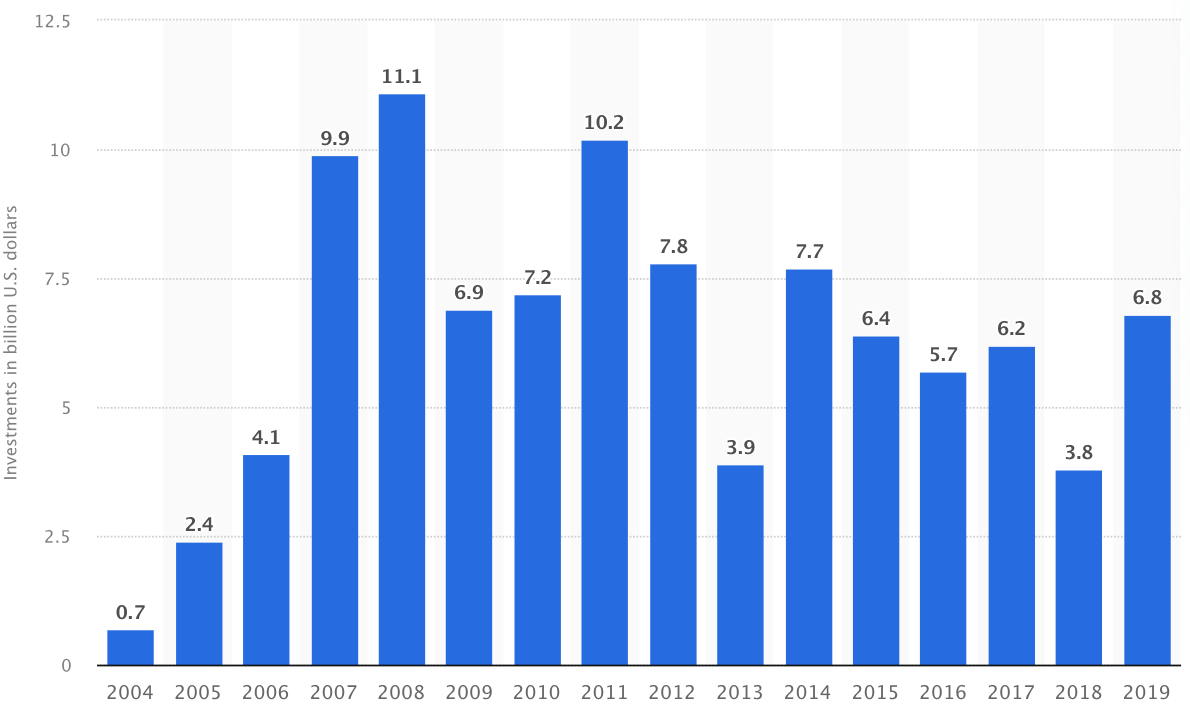
Figure 3 – Brazilian total investments in renewable energies - 2004 - 2019. Source: Statista (2022).
There were other policies about energy and renewables in the last years, including some related to efficiency and poverty. Over the years, all these efforts developed an uneven pattern of investments in RE in Brazil, as it can be noticed in Figure 3. However, what becomes clear while tracing the chronology of these elements of a socio-technical assemblage of energy transition is the political and technical vulnerability of Brazil. Technical vulnerabilities are observed in the shortness of governmental incentives to promote innovation on RE. The Inova initiatives were good, but they concluded without destabilizing the market, penetrating RE on a large scale, or leaving any substitute initiative. Political vulnerabilities are observed in the inexistence of clear and comprehensive objectives about what role modern renewables represent in the economy and society.
The political vulnerability seems to encounter some controversial solutions. The world has been discussing energy transitions for more than a decade, but only in 2021 Brazil approached it. There is a Project of Law, No. 327/2021, to establish a National Policy for Energy Transition (Ponte – Política Nacional da Transição Energética), which intends to address good answers to incentive RE generation, finance public policies in this manner, and decarbonize the economy, among others. However, we advocate in this paper for a more decentralized generation and destabilization of the current energy system. Without this, any policy into force will simply raise the RE share without the structural effect of a transition. This controversy is followed by Law No. 14.300/2022, vulgarly called “solar tax”. In short, the law intends to progressively reduce the compensation in the energy bill for solar in residences from 90% to 20% by 2045. This law will enter into force in 2023 and will represent a discouragement to installing a micro solar plant in residences, and one more challenge to engage transition.
To improve its national energy supply and promote development, Brazil must increase its share of RE and stimulate a transition combining the public and private sectors and end-user generation efficiency. Considering the relevance of the private sector, the State has a direct and guided responsibility for driving the innovation environment to promote the transition (Mazzucato 2015, Labussière & Nadai 2018). However, political problems are just a portion of the challenges. Infrastructural problems seem to play a large role in the country.
Our second assumption expresses that the country already has a relatively clean energy matrix compared to most countries, discouraging more significant efforts toward a complete energy transition. Brazil stands out as the largest regional producer of primary energy, with 287.6 MTEP in 2020, registering a decrease of 2.2%, compared to 2019 (MME 2021). Despite this, primary production exceeds demand by 11% (OLADE 2022), allowing energy export and stimulating the creation of interdependent regional arrangements. Figure 4 presents the energy balance (MME 2021).
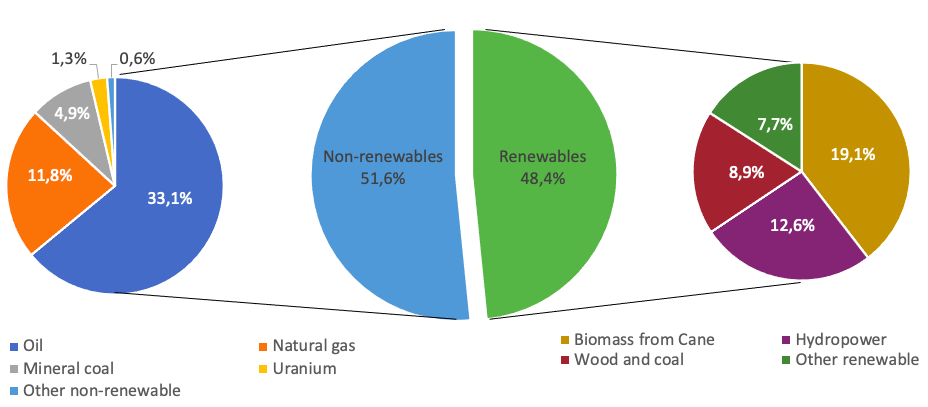
Figure 4 – Distribution of Brazilian Internal Energy Supply in 2020. Source: MME (2021).
Although Brazil is the seventh largest emitter of greenhouse gases, especially considering emissions from land use (mainly deforestation and burning), ambitious plans to reduce emissions indicate that it will reach zero by 2050. There have been some incentives for greater diversification of energy resources, and efforts can be made to expand the supply of renewables. The country already has a long history of using renewables, such as hydroelectricity and biomass (Castro 2021). When comparing the evolution of the Brazilian energy supply with that of the world, we observe a tendency to expand RE technologies, as shown in Figures 5 and 6.
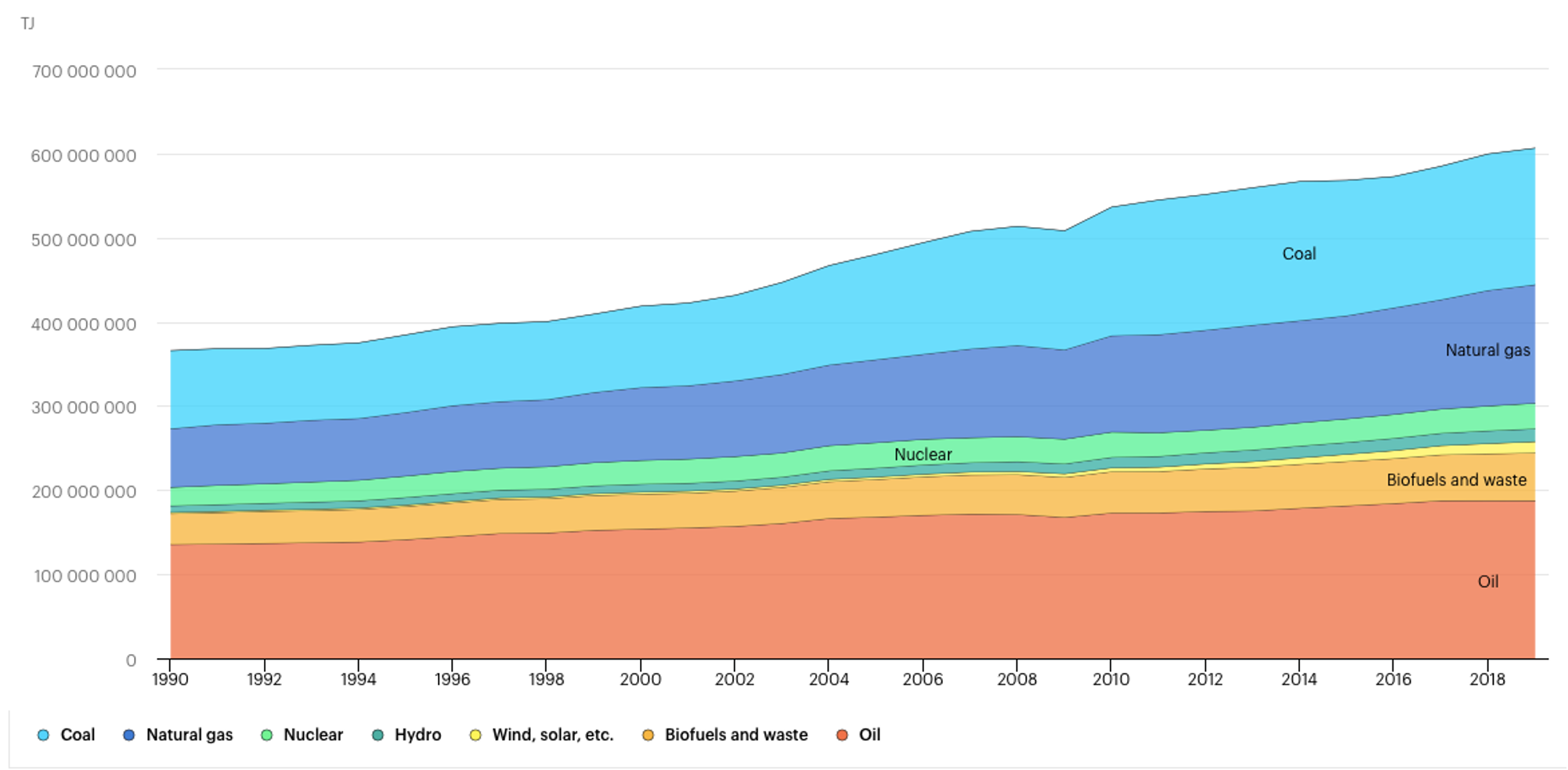
Figure 5 – Evolution of total energy supply by source, World 1990-2019. Source: IEA (2022).
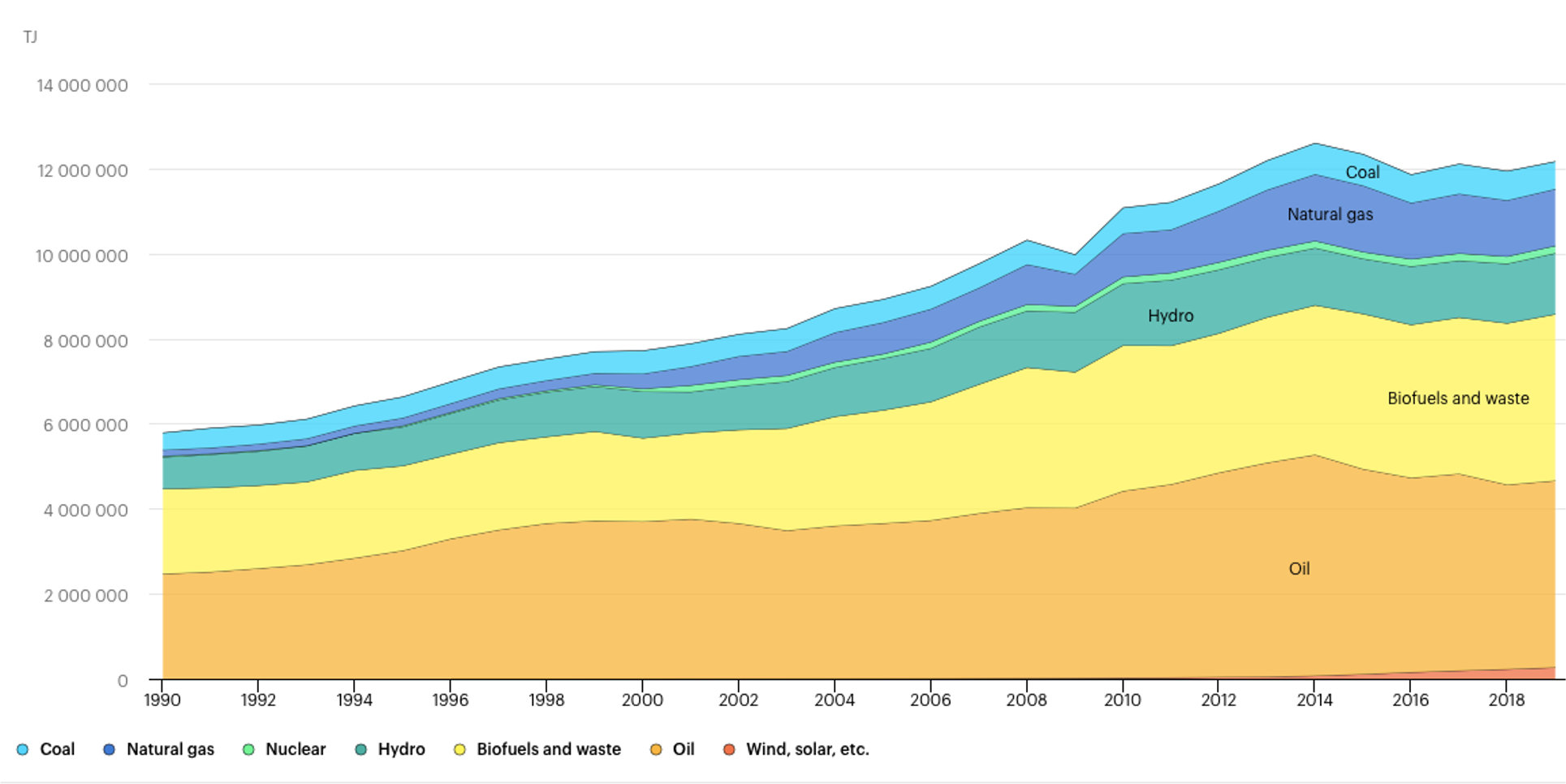
Figure 6 – Evolution of total energy supply by source, Brazil 1990-2019. Source: IEA (2022).
Brazil has made efforts to present itself as a regional power due to its size, population, and political and economic influence. The country depends on hydroelectric power and oil for transportation. Table 2 indicates an increase of almost 50% in hydroelectric generation capacity. It is important to note that the wind power generation capacity has grown significantly since 2000 and it is currently the fourth most important. The installed capacity for solar generation has increased considerably since 2015. Thermal, fossil and effluents increased too, but not on the scale of the sources mentioned above. The increase in the share of alternative sources is due to the drop in the percentage of hydro generation (Castro 2021). Therefore, the projections indicate renewables and thermal as the main ones responsible for increasing installed capacity, a trend that already appears in Table 2.
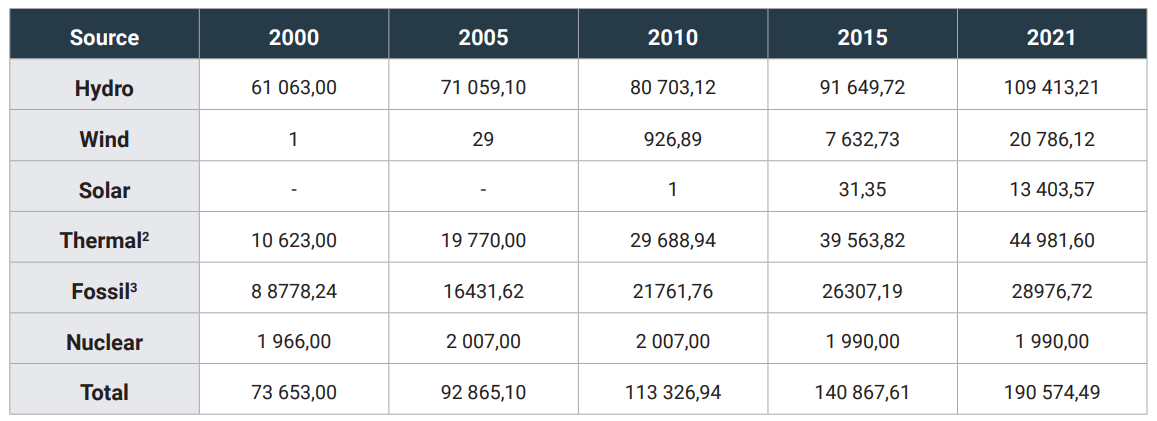
Table 2 – Installed electricity generation capacity in MW units - 2000-2021. Source: SIE Brasil (2022).
Wind energy is prominent when considering all renewables. However, its share is still relatively small. Therefore, considering energy security, some alternatives are relevant, such as the use of thermal plants to supply the demand, more viable in the short and medium term. Despite investments in cleaner sources, natural gas guarantees energy supply, with less GHG emissions (Castro 2021). Despite this, the matrix remains predominantly clean due to the still large and significant participation of the hydro.
Thus, we observe that the Brazilian energy transition process involves replacing more polluting sources with natural gas, which contributes to reducing emissions. But it does not cause remarkable changes toward a more ambitious energy transition, or even reduce dependence on hydroelectricity. Figure 7 presents the electricity balance of the country.
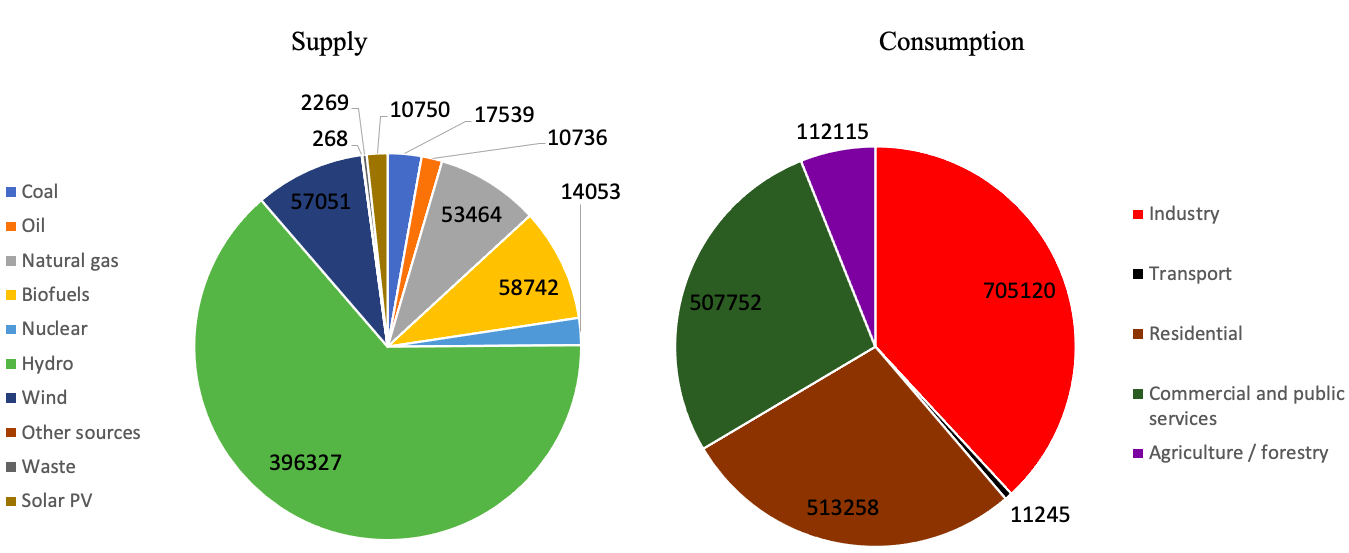
Figure 7 – Brazilian electrical balance by source in 2020. Source: Based on IEA (2022).
More than 70% of the electricity generated in Brazil comes from renewable sources, which is very good compared to the global perspective (MME 2018). However, despite this good initiative concerning the clean electricity mix, there are some problems: 1) the predominance of hydro in the energy mix-dependence on a single source is not good, especially with more than ten large plants such as Itaipu and Belo Monte (the latter with widespread disapproval) and thousands of SHS and CHS; 2) the construction of dams provokes a tremendous environmental impact, with modification of the local micro-ecosystem, loss of species, and causes changes in the local climate; 3) potential deterioration of turbines (Caus & Michels 2014).
Brazil is still dependent on oil as a source of energy for transportation. With 18 refineries, the transport is highly concentrated in the road modal, corresponding to 1.548 billion NTK (65%), followed by rail with 356 billion NTK, and finally by cabotage with 249.9 billion NTK. It is important to note that, due to the discovery of pre-salt areas, MME began to regulate oil extraction in 2006, and started selling it in 2008. Petrobras was the only firm allowed to operate the extraction and be a partner with other companies, but had a share of 30%, and these decisions show the country's concerns toward the pre-salt. However, in 2015, the current secretary Marco Antonio Martins reassured this political position, arguing that Brazil would be a great oil exporter in ten years, reaching the so-called energy independence (MME 2018). Far more to achieve independence, which is a matter of technological advance to reach consumption demand and energy intensity, the development of a country follows the track of energy. This means that, in a big country dependent on hydropower, some locations far from it should be encouraged to develop RE as their main energy supply.
Finally, our third assumption is that the extension of the territory makes it difficult to extend transmission lines, mainly to the Amazon Rainforest region. We mentioned that the Northeast region had more companies that win the solar and wind auctions. The development of wind and solar installed capacity inside the country for rational reasons must observe the potential for the wind to blow and the sun to shine. But interesting to notice is that every state has some contributions to RE generation, as noticed in Table 3.
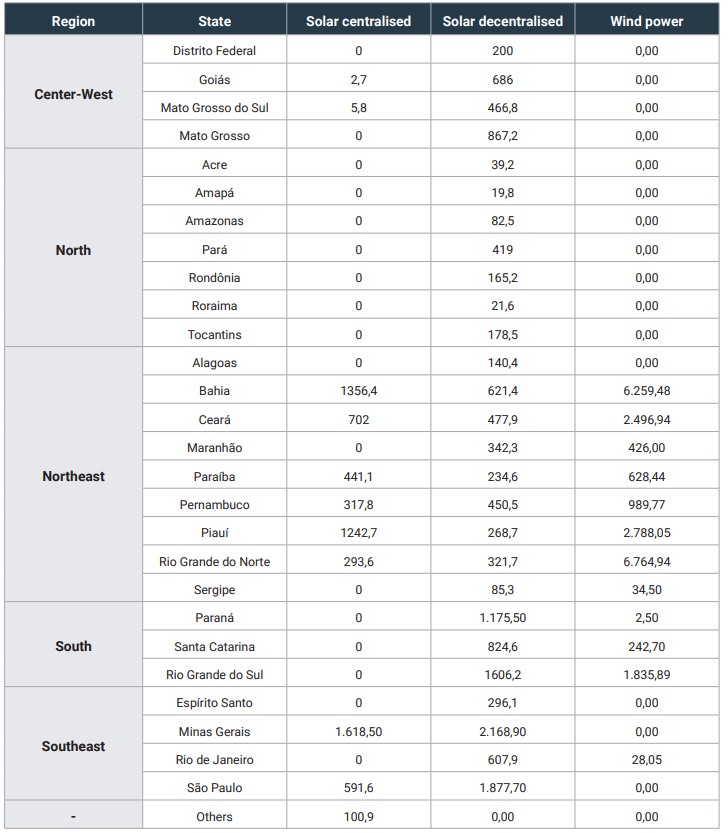
Table 3 – Distribution of solar and wind power in Brazil in 2022 (MW). Source: ABSOLAR (2022) and ABEÓLICA (2022).
Brazil is a big country, concentrating a huge portion of wind power plants in the North and the South, where the wind strongly blows, but with an uneven distribution of solar plants, centralized or not. The country seems to be developing its RE capacity without observing the real energy demands of each state. Although auctions succeeded to insert more competitive firms, it is not possible to observe the same for the transmission lines. The Energy Information System (SEI Brasil) provides information for two variables in this sense: the installed capacity of transmission lines; and the installed capacity of substations (MME, 2021). Table 4 shows that, since 2000, there has been a significant increase in both capacities.

Table 4 – Installed capacity of transmission lines and substations - 2000-2021. Source: SIE Brasil (2022).
It is difficult to access the Northern region, which has a minor presence of renewables, and the installed capacity of electricity generation is relatively low compared to the country´s. The breadth of the Northern territory makes it difficult to extend transmission lines, especially to the Amazon Rainforest region. Table 4 presents that hydroelectric has the highest installed capacity in the Northern region, and its increase between 2015 and 2021 is probably due to Belo Monte Plant operations. But wind power generation is almost non-existent, and solar is deficient. Therefore, the region remains highly dependent on hydroelectricity.

Table 5 – Installed Electric Power Generation Capacity from the Brazilian Northern Region - 2015-2021. Source: SIE Brasil (2022).
The Brazilian government has invested in exploring less polluting natural gas and has built new thermal plants in the North and Northeast regions. In addition, there are investments in the construction of small energy-generating units, mainly solar, in communities without access to the conventional grid. In the same direction, small hydroelectric plants are installed (OLADE 2022). However, considering these initiatives, efforts toward a more profound transition remain slow.
CONCLUSION
The socio-technical assemblage of energy transition requires far more than just moving from a dirty to a cleaner energy mix. For Brazil, the socio-technical objective has already been achieved. But when it comes to raw investments for transitions around transmission lines, science, technology, innovations, social equity, and energy poverty, our data were able to grasp the surface of the problem and open an agenda for International Relations scholars.
Junior et al. (2016) discussed that there is a lack of clear goals in the Brazilian energy policy, even more when we touch upon renewable energies. He designed three main scenarios in which the transition may occur: 1) moving deeply toward a clear and renewable matrix with a massive presence of wind and solar power, disrupting the current energy market dominated by hydro and biofuels; 2) engaging in an energy transition but relieve high importance to natural gas as a substitute in the short term for hydro, and avoiding greater impact on the transportation sector and its electrification; 3) relying on the traditional and already renewable energy matrix with great dependence on hydro for electricity and biofuels for transportation, slowly reducing oil shares.
Transitions are far more important than just emissions reduction because they are associated with a socio-technical assemblage. The benefits of State investments in renewable energy innovations and their diffusion are intrinsically related to the development of the 21st century economy, which is highly dependent on energy efficiency and intensity, reduction of energy poverty, and avoidance of climate threats.
Based on the short description of the scenarios, in 2022 Brazil seems to be running in the 2nd scenario. Transitions are far more important than just emissions reduction because they are associated with a socio-technical assemblage. The benefits of State investments in renewable energy innovations and their diffusion are intrinsically related to the development of the 21st century economy, which is highly dependent on energy efficiency and intensity, reduction of energy poverty, and avoidance of climate threats. Transitions are about investing more in disruptive innovations, a creative destruction specification process in the market and the way end-users interact with the product. It is about defining a mission to be solved in the three levels where the governance takes diversity into consideration. The amplification in the STA is only possible if the region and the country look at energy as a driver for their future, a mission (Labussière & Nadai 2018, Mazzucato 2015).
The use of natural gas as an alternative to hold the price of energy and mature renewables in the market is a strategy used since the beginning of the 21st century, mainly by the European Union countries. Precisely, since 2011 and the German Energiewende–energy transition–, most of the member States have moved to a more “aggressive” remodeling of the energy sector, bringing on modern renewables as pinpoints for transition.
Following this discussion, the question that guided our research was–what can explain the apparent Brazilian slowness in creating a socio-technical assemblage of energy transition regarding the challenges related to the impacts of climate change? This question was discussed based on three assumptions presented at the end of the introductory section.
We verified that there is a significant slowness in the Brazilian energy transition process. The fact that the country already has a cleaner energy matrix than most countries around the world discourages more investment in modern renewable energies. We can see it in the development of installed power generation capacity: wind and solar modalities are still inexpressive when compared, for example, to the development of hydroelectric generation capacity. Data from 2021 show that while hydroelectric generation capacity represented about 57% of the total, wind and solar represented about 10% and 7%, respectively. There is an increase in the installed capacity to generate energy from fossil and thermal sources, the latter being the use of natural gas, which can be included among fossil sources, although less polluting.
Part of the specialized literature shows that Brazil has adopted a middle path, substituting oil for natural gas. Some European countries have adopted this alternative, together with other measures such as the stimulus to the renewable market, to provide the conditions for a more profound energy transition. In the Brazilian case, this alternative has not been accompanied by a greater stimulus to deepen the transition. As we have seen, the installed capacity of wind and solar energy, although it has developed, still makes up a tiny part of the total. It indicates the need for more investments in the sector.
As for the third assumption, the coverage of demand by the conventional network serves most Brazilian regions. We are aware of the very uneven population distribution across the Brazilian territory, but there is also a very uneven distribution of the installed capacity of power generation substations. Moreover, despite the expansion of transmission lines, part of the population of the North region is still in need of access to the conventional system. The Brazilian government has invested in small energy-generating units, but we did not find documents that brought sufficient information about hydroelectric, renewable, or other sources. Even so, information about these small units shows that they are initiatives for very localized supply, especially for isolated communities, and that, in terms of meeting demand and adding renewable sources to the more global supply, these initiatives are very timid.
It is important to note that, in the Brazilian case, the relevance of the energy transition is not exclusively due to efforts to reduce GHG emissions, since the energy sector was responsible, in 2019, for about 19% of total national emissions (IEMA 2020). Instead, the relevance of this transition is precisely to expand the opportunities for the country's development, notably in technological development, with the opening for the modernization of several economic sectors, due to the chains related to renewable energies. The hydroelectric and oil sectors' interests and their influence on the formulation of Brazilian policies for the energy sector are important topics to be studied further. These old and well-established interests may block new opportunities and new energy markets. However, as already mentioned, this topic needs further investigation.
Acknowledgment
We thank the research group members who were responsible for collecting local data and conducting interviews. This work was supported by Projeto CNPQ 405013/2016-7 CHAMADA UNIVERSAL MCTI/CNPq No 01/2016, and; Fundação de Amparo à Pesquisa do Estado de Minas Gerais – (Fapemig) Projeto APQ-01085-16 Chamada 01/2016 - Demanda Universal.
ABSOLAR.2022. Infográfico ABSOLAR. Associação Brasileira de Energia Solar Fotovoltaica. https://www.absolar.org.br/mercado/infografico/.
ABEÓLICA. 2022. “Infovento #27”. Associação Brasileira de Energia Eólica, 12 de setembro de 2022. https://abeeolica.org.br/wp-content/uploads/2022/09/2022_09_InfoVento27.pdf.
Avelino, F. 2017. “Power in Sustainability Transitions: Analyzing Power and (dis) Empowerment in Transformative Change towards Sustainability”. Environmental Policy and Governance 27 (6): 505–520. https://doi.org/10.1002/eet.1777.
Avelino, F. & J. M. Wittmayer. 2016. “Shifting Power Relations in Sustainability Transitions: a Multi-actor Perspective”. Journal of Environmental Policy & Planning 18 (5): 628–649. https://doi.org/10.1080/1523908X.2015.1112259.
Brasil, Ministério de Infraestrutura. S/d. Transporte rodoviário de cargas. https://www.gov.br/infraestrutura/pt-br/assuntos/transporte-terrestre/transporte-rodoviario-de-cargas.
Brasil. 2016. Plano Nacional de Adaptação à Mudança do Clima. http://www.mds.gov.br/webarquivos/arquivo/seguranca_alimentar/caisan/Publicacao/Caisan_Nacional/PlanoNacionaldeAdaptacaoaMudancadoClima_Junho2015.pdf.
Castro, Nivaldo José. 2021. “Implicações da transição energética para a matriz elétrica no Brasil e no mundo”. In A geopolítica da energia do século XXI, organizado por Guilherme Sandoval Goes. Rio de Janeiro: Synergia.
Caus, T. R., Michels, A. 2014. Energia hidrelétrica: eficiência na geração. Rio Grande do Sul: UFSM. https://repositorio.ufsm.br/bitstream/handle/1/1380/Caus_Tuane_Regina.pdf?sequence=1.
Csiba, K. 2016. Energy Poverty: handbook. The Greens/EFA group of the European Parliament. European Union. https://www.bpie.eu/wp-content/uploads/2016/11/energypovertyhandbook-online.pdf.
Criekemans, D. 2018. “Geopolitics of the Renewable Energy Game and its Potential Impact upon Global Power Relations”. In The Geopolitics of Renewables, organizado por Scholten, D., 37–73. Lecture Notes in Energy, vol 61. Springer, Cham. https://doi.org/10.1007/978-3-319-67855-9_2.
Dauvergne, P., & BL Farias, D. 2012. “The Rise of Brazil as a Global Development Power”. Third World Quarterly 33 (5): 903-917. https://doi.org/10.1080/01436597.2012.674704.
Delgado, Fernanda; Nogueira, Luiz A. Horta. 2020. “Brasil: o país que já fez a transição energética”. Revista Conjuntura Econômica: FGV 74 (12): 50-53. http://docvirt.com/docreader.net/Conjun_D20/869.
Graf, P. 2015. “Eco-innovation–a New Paradigm for Latin America?” Revista Gestão e Desenvolvimento 12 (1): 148-159. https://doi.org/10.25112/rgd.v12i1.52.
Halsnaes, K; Markandya, A; Shukla, P. 2011. “Introduction: Sustainable Development, Energy, and Climate Change”. World Development 39 (6): 983–986. http://dx.doi.org/10.1016/j.worlddev.2010.01.006.
IEA. Projected Costs of Generating Electricity. https://www.oecd-nea.org/ndd/pubs/2015/7057-proj-costs-electricity-2015.pdf.
IEA. 2022. Statistics. International Energy Agency. https://www.iea.org/statistics.
IRENA. 2020. Finance & Investment. International Renewable Energy Agency. https://www.irena.org/financeinvestment.
Junior. H. Q. P., Almeida, E. F., Bomtempo, J. V., Iootty, M., Bicalho, R. G. 2016. Economia da energia - fundamentos econômicos, evolução histórica e organização industrial. 2a Ed. São Paulo: GEN LTC.
Kern, Florian; Markard, Jochen. 2016. “Analyzing Energy Transitions: Combining Insights from Transition Studies and International Political Economy”. In The Palgrave Handbook of the International Political Economy of Energy, organizado por Van de Graaf, T., Sovacool, B., Ghosh, A., Kern, F., Klare, M., 291-318. Palgrave Handbooks in IPE. London: Palgrave Macmillan. https://doi.org/10.1057/978-1-137-55631-8_12.
Labussière, O., & Nadaï, A. (Eds.). 2018. Energy Transitions: a Socio-technical Inquiry.
Energy, Climate and the Environment Series. Springer. Palgrave Macmillan Cham. https://doi.org/10.1007/978-3-319-77025-3.
Lima, T. C. 2009. “O princípio das responsabilidades comuns mas diferenciadas no Direito Internacional Ambiental”. Revista Eletrônica de Direito Internacional 4: 160-197.
Mazzucato, M. 2015. The Green Entrepreneurial State. SPRU Working Paper Series. SWPS 2015-28. https://dx.doi.org/10.2139/ssrn.2744602.
Markard, J., Raven, R., & Truffer, B. 2012. “Sustainability Transitions: An Emerging Field of Research and its Prospects”. Research Policy 41(6): 955–967. https://doi.org/10.1016/j.respol.2012.02.013.
MMA. 2022. Ministério do Meio Ambiente. Apresentação. http://www.mma.gov.br/institucional.
MME. 2018. Balanço Energético Nacional 2018. http://epe.gov.br/pt/publicacoes-dados-abertos/publicacoes/balanco-energetico-nacional-2018. OLADE. Panorama Energético de América Latina y el Caribe 2021. Organización Latinoamericana de Energía. https://www.olade.org/publicaciones/panorama-energetico-de-america-latina-y-el-caribe-2021.
Peters, M., Köhler, B., Kuckshinrichs, W., Leitner, W., Markewitz, P., & Müller, T. E. 2011. “Chemical Technologies for Exploiting and Recycling Carbon Dioxide into the Value Chain”. ChemSusChem 4 (9): 1216-1240. https://doi.org/10.1002/cssc.201000447.
O’Sullivan, M., Overland, I., & Sandalow, D. 2017. The Geopolitics of Renewable Energy. Working Paper (June 2017). Center on Global Energy Policy, Columbia University & The Geopolitics of Energy Project, Belfer Center for Science and International Affairs, Harvard Kennedy School. https://energypolicy.columbia.edu/sites/default/files/CGEPTheGeopoliticsOfRenewables.pdf.
Scholten, D., Bazilian, M., Overland, I., & Westphal, K. 2020. “The Geopolitics of Renewables: New Board, New Game”. Energy Policy 138: 111059. https://doi.org/10.1016/j.enpol.2019.111059.
SIE Brasil. 2022. Capacidade instalada de geração de energia elétrica. Banco de dados. Olade - Organización Latinoamericana de Energía. https://www.mme.gov.br/SIEBRASIL/consultas/reporte-dato42-jerarquizado.aspx?oc=471&or=472&ss=2&v=1.
SIE Brasil. 2022. Capacidade instalada de linhas de transmissão. Banco de dados. Olade - Organización Latinoamericana de Energía. https://www.mme.gov.br/SIEBRASIL/consultas/reporte-dato42-jerarquizado.aspx?oc=30183&or=30184&ss=2&v=1.
Silva, M. S. D. 2018. A política externa brasileira para mudanças climáticas: agendas ambientais distintas ou processos de uma mesma política governamental. Tese (Doutorado em Relações Internacionais). PUC-Minas.
Souza, M., & L. Gomes Ferreira. 2020. “A formação do complexo regional de segurança energética pela Energiewende na União Europeia”. Meridiano 47 – Boletim de Análise de Conjuntura em Relações Internacionais 21. https://doi.org/10.20889/M47e21003.
UN. 2022. Sustainable Development Goals. Nações Unidas. https://sdgs.un.org.
Aubmitted: November 14, 2022
Approved for publication: Novembro 17, de 2022.
Copyright © 2022 CEBRI-Journal. This is an Open Access article distributed under the terms of the Creative Commons Attribution License, which permits unrestricted use, distribution, and reproduction in any medium, provided the original article is properly cited.